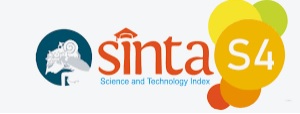Prediksi Harga Jual Beras Eceran Menggunakan Metode K-Nearst Neighbor Di Kabupaten Manokwari
Abstract
The retail price of rice sold in markets in Manokwari district fluctuates every year. This can make it difficult for traders to determine the ideal retail selling price for rice to the people of Manokwari, because some people in Manokwari have a mediocre income. This research aims to determine the prediction of retail rice selling prices based on year. The method used is the classification method with the K-Nearest Neighbor algorithm. Testing was carried out using the Rapid Miner Studio tools. The output of the Root Mean Square Error (RMSE) test results is 981,735, while for testing the Mean Absolute Error (MAE) is used with an accuracy value of 627,074. Even though the MAE accuracy value is smaller than RMSE, the error value varies. Based on the results of research that has been carried out, a Prediction Average value of 13438.362 is obtained, which shows that the average rice price predicted by the model is slightly higher than the actual one, and a Squared Correlation (R-squared) value of 0.393 which explains that there is around 39% variability Rice prices can be explained by the model used in the research.
Keywords: Prediction; Rice Prices; K-Nearest Neighbor Algorithm; Rapid Miner Studio.
Keywords: Algorithm, Rice, Price, K-NN, Prediction
Â
Abstrak
Harga beras eceran yang dijual di pasar-pasar yang ada di kabupaten Manokwari mengalami fluktuasi setiap tahunnya. Hal ini dapat membuat para pedagang sulit untuk menentukan harga jual beras eceran yang ideal kepada para masyarakat manokwari, karena bagi sebagian masyarakat manokwari memiliki pendapatan yang pas-pasan. Penelitian ini bertujuan untuk memprediksi harga jual beras eceran berdasarkan tahun. Metode yang digunakan adalah metode klasifikasi dengan algoritma K-Nearest Neighbor. Pengujian dilakukan dengan menggunakan tools Rapid Miner Studio. Â Output hasil pengujian Root Mean Square Error (RMSE) sebesar 981.735, sedangkan untuk pengujian menggunakan Mean Absolute Error (MAE) dengan nilai akurasi sebesar 627.074. Meskipun nilai akurasi MAE lebih kecil dari RMSE, namun nilai kesalahan bervariasi. Berdasarkan hasil penelitian yang telah dilakukan, diperoleh nilai Prediction Average sebesar 13438.362 yang menunjukkan bahwa harga beras rata-rata yang diprediksi oleh model sedikit lebih tinggi dari yang sebenarnya, dan nilai Squared Correlation (R-squared) sebesar 0.393 yang menjelaskan bahwa sekitar 39 % variabilitas harga beras dapat dijelaskan oleh model yang digunakan pada penelitian.
Â
Keywords
References
T. Siburian, M. Safii, and I. Parlina, “Penerapan Algoritma K-Means Clustering untuk Pengelompokan Harga Eceran Beras di Pasar Tradisional Berdasarkan Wilayah Kota,†Pros. Semin. Nas. Ris. Inf. Sci., vol. 1, no. September, pp. 927-936, 2019, doi: 10.30645/senaris.v1i0.101.
N. Hermanto and N. Saptana, “Kebijakan Harga Beras Ditinjau dari Dimensi Penentu Harga,†Forum Penelit. Agro Ekon., vol. 35, no. 1, pp. 31-43, 2018, doi: 10.21082/fae.v35n1.2017.31-43.
M.A. Sitinjak, "Indeks Harga Komsumen (IHK) di Lampung Menggunakan Autoregressive Integrated Moving Average (ARIMA)". Indonesian Journal of Applied Mathematics, vol. 3, no.1, pp. 15-20, 2023.
M. H. Iku, I. Surya Kumala, and Y. A. Mustofa, “Metode K-Nearest Neighbor untuk Memprediksi Harga Eceran Beras di Pasar Tradisional Gorontalo,†J. Nas. cosPhi, vol. 3, no. 2, pp. 50-53, 2019.
Mukhlisin, M. Imrona, and D. T. Murdiansyah, “Prediksi Harga Beras Premium dengan Metode Algoritma K-Nearest Neighbor,†e-Proceeding Eng., vol. 7, no. 1, pp. 5-2714, 2019.
Rismala, I. Ali, and A. Rizki Rinaldi, “Penerapan Metode K-Nearest Neighbor Untuk Prediksi,†JATI (Jurnal Mhs. Tek. Inform., vol. 7, no. 1, pp. 65-85, 2023.
A. S. Ilmananda and D. A. Alfianty, “Prediksi Rata-Rata Harga Beras Nasional dengan Kualitas Premium di Tingkat Penggilingan hingga Akhir Tahun 2022,†Semin. Nas. Sist. Inf., no. December, pp. 3385-3393, 2022.
F. D. Astuti and M. Guntara, “Analisis Performa Algoritma K-NN Dan C4.5 Pada Klasifikasi Data Penduduk Miskin,†J. Rekayasa Teknol. Inf., vol. 2, no. 2, pp. 135-144, 2018, doi: 10.30872/jurti.v2i2.1865.
P. Partono, H. N. Wardhani, N. I. Setyowati, A. Tsalitsa, and S. N. Putri, “Strategi Meningkatkan Kompetensi 4C (Critical Thinking, Creativity, Communication, & Collaborative),†J. Penelit. Ilmu Pendidik., vol. 14, no. 1, pp. 41-52, 2021, doi: 10.21831/jpipfip.v14i1.35810.
P. M. Shakeel, M. A. Burhanuddin, and M. I. Desa, “Lung cancer detection from CT image using improved profuse clustering and deep learning instantaneously trained neural networks,†Meas. J. Int. Meas. Confed., vol. 145, pp. 702-712, 2019, doi: 10.1016/j.measurement.2019.05.027.
V. N. Budiyasari, P. Studi, T. Informatika, F. Teknik, U. Nusantara, and P. Kediri, “Implementasi Data Mining Pada Penjualan kacamata Dengan Menggunakan Algoritma Apriori,†Indones. J. Comput. Inf. Technol., vol. 2, no. 2, pp. 31-41, 2017.
A. P. Windarto, “Penerapan Datamining Pada Ekspor Buah-Buahan Menurut Negara Tujuan Menggunakan K-Means Clustering Method,†Techno.Com, vol. 16, no. 4, pp. 348-359, 2017, doi: 10.33633/tc.v16i4.1447.
Rahmawati and E. M. I. Putri, “Learning From Home dalam Perspektif Persepsi Mahasiswa Era Pandemi Covid-19,†Pros. Semin. Nas. Hardiknas, vol. 1, pp. 17-24, 2020, [Online]. Available: https://proceedings.ideaspublishing.co.id/index.php/hardiknas/article/view/3
A. Haditsah, “Klasifikasi Masyarakat Miskin menggunakan Metode Naïve Bayes,†Ilk. J. Ilm., vol. 10, no. 2, pp. 160-165, 2018.
S. M. Azhari, T. H. Pudjiantoro, and I. Santikarama, “Klasterisasi Outlet Berdasarkan Data Penjualan Dengan Menggunakan Algoritma K-Medoids,†JUMANJI (Jurnal Masy. Inform. Unjani), vol. 5, no. 2, p. 69-79, 2021, doi: 10.26874/jumanji.v5i2.93.
How To Cite This :
Refbacks
- There are currently no refbacks.











